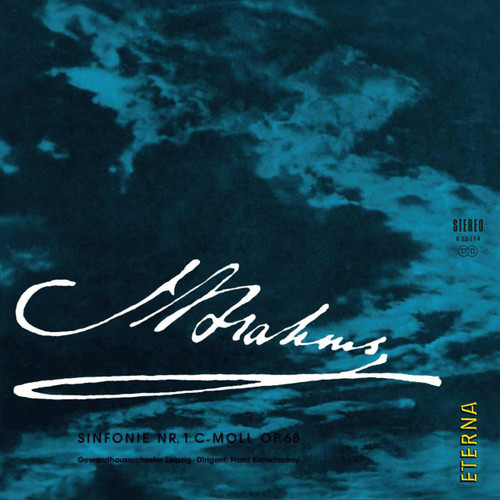Release Date To Be Announced pre-order your copy today! Orders with both pre-order and in stock items will have all in stock items shipped immediately!
Master Quality Reel To Reel Tape!
This item not eligible for any further discount offers!
Apart from high-profile concert activities, Franz Konwitschny was inseparably associated with the foundation and development of the new Eterna label. Between 1959 and 1961 Eterna issued all Beethoven's and Schumann's symphonies in the then innovative stereo format. Like all Konwitschny's late recordings, these gramophone records are now sought-after collector's items that offer interpretations of lasting significance.
One such notable document of the great maestro is the present recording of Johannes Brahms' First Symphony, made in June 1962 only weeks before Konwitschny's death. The producer of this recording, Dieter-Gerhardt Worm, praises "the coherence and euphony of the interpretation. Konwitschny does nothing subjectively, he interprets the work. When I played Konwitschny the recording in hospital before his last concert tour, tears of joy rolled down his face." Worm, who worked on most of Konwitschny's recordings as a young production manager for the Eterna label, remembers the focused studio work and the immense artistic importance of the conductor: "As a conductor, he was always one of the greatest for me. What he did as a Bruckner conductor, for instance, was incredible. Konwitschny was more than a musician to whom one could say anything; he was someone who knew instinctively how to apply what he had learnt and integrate it into his conducting gestures."
DOES HORCH HOUSE DO ANY KIND OF REMASTERING DURING THE COPYING PROCESS?
Absolutely not! Why mess with the best? The whole point of what they do lies in capturing the magic of the original analogue master tape in its purest, most faithful form possible.
'Remastering' can be compared to using computer software to edit an original photograph. The benefits are that you can remove unwanted marks or noise, clean things up, remove distortion and boost clarity. The downside is that in doing so, you often lose the natural essence of the original and the result can seem rather synthetic, lacking in real life character.
The unfortunate fact is that tapes, like photographs, do tend to age over time, and most analogue masters are now between 30-80+ years old.
So Horch House undertake a painstaking 'soft refurbishing' process, which is key to recapturing the original quality of a master tape.
CAPTURING THE MAGIC OF MASTER TAPE
How exactly does Horch House translate an original analogue master tape into faithful copies on reel-to-reel tape and vinyl records?
They use a process that's been meticulously researched and developed by their expert team of sound engineers, with input from some of the world's leading specialists.
The first step is to carefully assess the sound quality of the original master tape, which their experts do in great detail. The unfortunate fact is that tapes do tend to age over time, and most analogue masters are now between 30-80+ years old. What they're looking to do, therefore, as an integral part of their copying process, is to restore the sound quality back to its original level. They want you to hear exactly what the first sound engineers heard (and indeed the musicians themselves), on the day that the original recording was made. This is in stark contrast to any kind of 'remastering', which they most definitely do not do! They're not looking to 'improve' the recording in any way, but rather to return it as closely as possible to its full original beauty.
They call this their 'soft refurbishing' process.
HOW CLOSE ARE HORCH HOUSE COPIES TO THE ORIGINAL MASTER TAPES?
Horch House believe that they're as close as it's possible to get - not simply to the master tape in its current condition, but to that master tape's original condition. Thanks to their detailed 'soft refurbishing' process, their master tape copies
could, in a sense, now be considered as better than the current originals because they've been lovingly restored to deliver the same sound quality that the originals had on the day they were first recorded.
WHAT ABOUT COPYRIGHT? ARE MASTER TAPE COPIES LEGAL?
All Horch House master tape copies are fully authorized, licensed and approved by the relevant record label/music publisher.
** It is standard practice in all recording studios to keep the tape "tail out". This reduces "pre-echo" and it means that the tape should be placed on the right hand side of the recorder, re-wound and then played.
Features
- Studio Master Copy
- 2-Reel Tape
- Tape Material: RTM SM900
- Recording Speed: 15IPS - 38cm/sec
- Rec. Level (mag flux): 510 nWb/m
- Equalisation: CCIR
- Width & Tracks: 1/4" - 2 Track
- Reels: Metal - 10.5" - 26,5 cm
- Production on Studer machines refurbished to factory specification
- Handmade
- Recorded in the private studio of Hans Georg Brunner-Schwer
- Recording director & engineer: Hans Georg Brunner-Schwer
- Fully authorized, licensed & approved by the record label/music publisher
- Horch House Deluxe Packaging
Musicians
| Gewandhausorchester Leipzig | |
|---|---|
| Franz Konwitschny | conductor |
Selections
Johannes Brahms (1833-1897)
Symphony No. 1 In C Minor, Op. 68
- Un Poco Sostenuto - Allegro
- Andante Sostenuto
- Un Poco Allegretto E Grazioso
- Adagio - Piu Andante - Allegro Non Troppo, Ma Con Brio









